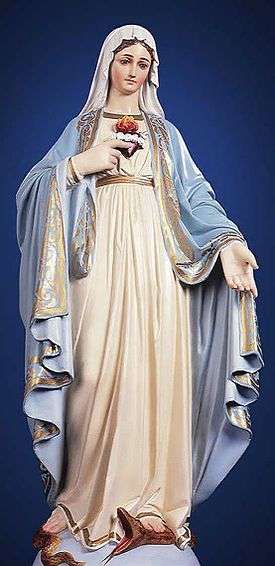Our Lady of Atonement
| Our Lady of Atonement Our Lady of Reconciliation | |
|---|---|
 | |
| Location | United States |
| Shrine | Baguio Cathedral, New York City. |
| Patronage | Of those who want to confess those who confess first, of sinners who seek change, young misunderstood to seek God and impossible. |
| Attributes | The Child Jesus, red and blue clothing, angels bearing the Instruments of the Passion |
Our Lady of Atonement (Latin: Domina Nostra Adunationis) is a celebrated Roman Catholic title of the Blessed Virgin Mary first invoked by Father (Louis) Paul T. Wattson, S.A. and Ms. Lurana White, a laywoman.
History and devotion
Under this Marian title many Catholics call Mary the European image was designed in Spain after the Spanish civil war. The US image was designed in New York and was propaganda of the Episcopal Society of the Atonement, and the first time the image was exposed in Graymoor farm chapel, New York in 1909 and was finally approved by the Roman Catholic Church in July 1946.
The party designated by Father Wattson this Marian title was registered on July 9 but change for the Second Sunday of Easter, the date approved by the Holy See for their religious devotion. The title is also very common among Anglicans and Anglo-Catholics who have a similar devotion in their liturgical traditions. The religious image is based on the passion of Jesus Christ, symbolized by the red cloak of the Virgin Mary and external angels fear surrounding Jesus Child with the instruments of his passion. [1]
tradution Aducionis
There are two images of the Virgin Mary under this title holds the US image in the child Jesus in a gesture cruciform. It is different from the title of Mary Help of Christians as the Virgin under this title has a red cape, but lacks a scepter, instead of having a child Jesus has a small crucifix and [2] features that adorn the angels with symbols and instruments of the passion of Jesus Christ, foremost among them the crown of thorns, nails, scourge and the pillar of the scourging and the INRI this has the title Domina Notra Auditionis, Auditionis word in Spanish means Audience or Reconciliation. The second image is designed European Spain after the Civil War and is known as the Immaculate Dolorosa and she has seen his transfer heart with a sword is dressed in white with a blue robe and head covers a white mantle.
Description of the Image
The European image shows Mary dressed in white with a blue mantle and a white mantilla, has among his pierced by a sword heart and means that Mary is a powerful intercessor for us before God because she redeemer and co-star of life of its son Christ our Lord. The American image holds the Child Jesus who is dressed in white and holding a cross and blessing the observer, the mother wears a blue dress means that it is a maiden and a red robe that signifies the blood of Christ and the love of Christ to go the passion to redeem men through his sacrifice that reflected in the angels bearing the instruments of the Passion, the Crown of Thorns, the Lance, the jug full of vinegar, whips, purple robe, cane, sponge attached to a rod, the title of the Cross and a Lily White means innocence and love of Christ saved us by his death and death on a cross. All this in a green symbol of hope and full of flowers are thanked by Christ.
Under this Marian title, the originally Episcopal Society of the Atonement propagates Marian devotion, first celebrated in Graymoor chapel farmhouse, New York in 1909 and was finally approved by the Roman Catholic Church in July 1946.[1]
The feast designated by Father Wattson to this Marian title is recorded on July 9, the date approved by the Holy See for its religious devotion. The title is also very common among Anglicans and Anglo-Catholics who have similar devotion in their liturgical traditions. The religious image draws on the Passion of Jesus Christ, symbolized by the red cloak of the Virgin Mary, and the external angels surrounding the frightened Child Jesus with the instruments of his passion.[2]
Legacy
There are two orders which emanated from the Marian devotion: the Franciscan Sisters of the Atonement and the Franciscan Friars of the Atonement. Both of which utilize the spirituality of Father Wattson in their respective religious communities.
The Cathedral of Our Lady of Atonement in Baguio, Philippines is named in honour of this devotion. This was a result of Anglican spirituality that was introduced to the Cordillera region by American Episcopalian missionaries in 1936. The Cathedral survived the Allied carpet bombing of the city towards the end of the Second World War. It is the see of the Catholic Bishop of Baguio.
Our Lady of Atonement Catholic Church is an Anglican Use parish that is part of the Roman Catholic Archdiocese of San Antonio, Texas. The Atonement Academy is its parochial school.
See also
References
| Wikimedia Commons has media related to Our Lady of Atonement. |